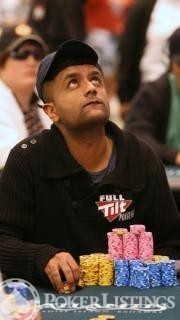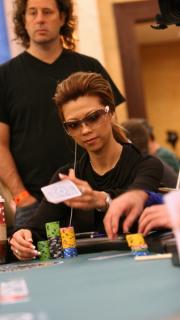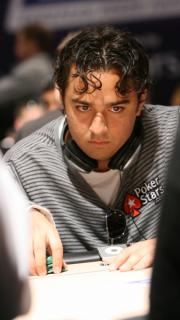In the game of poker, there are hundreds of odd situations
that can occur and numerous arcane rules that may or may not apply to
them.
When money is on the line, however, there needs to be a set, fair way to deal with all of these anomalies.
Plenty of players across poker forums, comment boards and in the real
world are always looking for answers as to these odd situations, so the
goal of this article is to create a definitive list of rules to resolve
these conundrums.Without further ado here is my list of odd situations
and Texas Hold'em poker rules.
All-In Situations
Two players all-in for different amounts: In this scenario,
you take the amount of the smaller stack from the big stack into the
pot, returning the difference to the big-stack player.
Short stack all-in against two players: When a short stack is
all-in against two larger stacks, the blinds, short stack, plus the
amount of the short stack from each larger stack is placed in the main
pot. All players are eligible to win this pot.
The two players on the side are now free to play and bet as usual
into a side pot, which only they are eligible to win. (This means there
can be two winners in the hand - a side pot and a main pot winner.)
Multiple players all-in: When multiple players are all-in, you
must make multiple side pots. Make a main pot as described above. After
you've done that, repeat the process with the next-smallest stack.
Continue to do this until all stacks are accounted for. Make sure to keep track of who is eligible for what pots.
Balancing Tables
If you're running a tournament with two tables, and table 1 loses two
cheat poker players while table 2 is still full, you're going to have to move one
player from table 2 to keep the tables balanced.
How to choose who moves is done by moving the player who is in (or
closest to) the same position relative to the button. So if the open
seat is in the cut-off on table 1, you want to move the player from the
cut-off on table 2.
This keeps players from having to pay blinds twice, or not at all.
Breaking a Table
If you lose enough players to be able to merge one table with another
(or multiple others), it's time to break the table. How to choose who
sits where is done by drawing for the open seats.
If you're moving everyone onto one final table, typically all
players, including those already seated at the table, draw for their
seat. If you don't have seat cards, just use the deck counting lowest
from highest, starting left of the dealer.
Can a Player Cash Out Half of Their Chips?
A player in a cash game has to play with all of their chips, or none.
Cashing out part of your stack (also known as going south) is against
the rules, and considered very poor etiquette.
If you would like to cash out only part of your chips, you must cash
out your entire stack, and wait the set amount of time before taking
your seat again.
This is known as recycling. The amount of time to wait changes
depending on where you're playing, but I've never seen it lower than 30
minutes (the default online recycle timeframe).
Can a Player Purchase More Chips Off Another Player?
This is never a good idea. It's essentially the same concept as going
south. The table loses the amount of chips the new player would be
buying in for.
Always buy your chips from the dealer or the house. In a home game,
one person should be in charge of all financial transactions.
Card Boxed in the Deck
If a boxed card (a card face up in the stub) is encountered at any
time during a hand, the card is removed from the deck and shown to every
player. The deal continues as if nothing went wrong.
If multiple cards are boxed, the dealer continues to remove the boxed
cards until he reaches a facedown card to continue the deal.
If the stub runs short of nonboxed cards, the hand is declared dead,
with all chips being returned to their original stacks as accurately as
possible.
Cards Dealt Before All Players Have Acted
If the dealer burns and turns fourth street while a player has yet to
make their flop decision, the play is temporarily halted. The dealer
takes the turn card and puts it back into the stub, shuffling the entire
stub sufficiently.
Once the deck is shuffled, and the player has made his final flop
action, the top card is turned over as the new turn (there has already
been a card burned for this street).
Card Exposed While Dealing
When dealing hole cards, if the first or second card you deal is
exposed (the face value was seen by someone at the table), the hand is a
misdeal, meaning the cards are reshuffled and the deal starts over (the
dealer button stays in the same place).
If a card other than the first or second is exposed, the dealer
continues to deal as if nothing had gone wrong. When the deal finishes,
he give the top card on the deck to the player with the flashed card,
and takes back the exposed card.
That card is then turned face up and shown to everyone at the table,
and put on the top of the deck to be used as the first burn card.
If two cards are exposed while dealing, the hand is considered a misdeal.
Card Marked
When noticing a single badly marked card in play, first play out the
hand normally. When the hand is complete you'll want to replace that
marked card with a new one of the same value, or just grab a new deck.
If you don't have a new deck and are stuck with the one you have,
your best bet is to remove the card from the game, making sure everyone
is aware that the card is no longer in play.
It's better for everyone to know that no one has the card than for everyone to know when someone does have the card.
Dealer Deals an Extra Hand or a Hand to a Seat with No Player
In this scenario, as long as no one looks at the extra hand, it's folded as a dead hand, and play continues as usual.
How Long Can a Player Wait Before Choosing to Rebuy?
After a player loses all of their chips, they must choose whether or not to rebuy before the next hand is dealt.
In a home game there is room for lenience on this issue, just as long
as the player isn't doing it on purpose to gain some sort of advantage.
Is a Single Over-Value Chip Considered a Raise or a Call?
By putting in one over-value chip without saying anything, it is
always considered a call. For example, if the big blind is $25 and
you're first to act, putting in a $100 chip without actually saying
"raise" is considered a call.
The more lenient atmosphere of a home game means the dealer will typically ask the player what they actually wanted to do.
Player Misses a Blind (Cash Games)
A player can never come into the game between the blinds, or between
the button and the blinds (unless they buy the button, see rule below).
This applies when moving a player in tournaments as well.
If a player misses his or her blind in a cash game, they're not
allowed to be dealt into a hand until the button has passed by them to
the player on their left (it's treated as if there is no
infrared contactlenses player sitting
there). When the button has passed, they must post the amount equal to
the blinds they missed.
For example, with blinds of $1/$2, a player who misses the big blind
(therefore forcing them to also miss the small blind), they must post $3
to be dealt into the hand.
A small-blind post is always considered dead, meaning it goes into
the pot and does not count toward any action in the hand, while the
big-blind portion of the post is live, meaning it does count.
A player with a live post still receives option to check or raise when it's their turn to act in the hand.
Buying the button: Buying the button is allowed in some
locations during a cash game. This means that when a player sits down
between the small blind and the button, or on the seat where the button
would be next, they have the option to pay both the small and big blind
in place of the players with whom the responsibility lies.
This allows the player to play on the button, rather than having to wait for it to pass them the next hand.
Player Misses a Blind (Tournaments)
In a tournament, every stack gets dealt a hand regardless of a player
being in the seat or not. When the last card is dealt to a player for
the hand, the hands without players are mucked.
Players not present during their blinds have the blinds posted for them from their stacks, referred to as blinding out.
Player's Stack Size Less Than the Blind
When a player's stack is less than the amount of the small blind,
they are automatically considered all-in in the next hand they play,
regardless of position.
If the player's stack is larger than the small blind but smaller than
the big blind, they will be considered all-in in any position other
than the small blind, assuming they fold for their option.
When all-in, the player can only win the amount of their stack, plus
that same amount from all of the callers and blinds. If the person has
less than the big blind, they can only win the portion of the blind
equal to that of their stack.
Removing Smaller Chips from Play
When the blinds increase in a tournament, eventually the
smaller-value chips will become obsolete. Once the chips are no longer
needed, they are chipped up to the next denomination.
First, make sure the chips are no longer needed (don't forget to
check for antes in the future blind levels). If the blinds are
$500/$1,000 doubling, you have no need for any chips smaller than $500
on the table.
Change as many low-value chips as you can into higher values and hold
on to the remainder. For example, if you have ten $25 chips, you will
receive two $100 chips and have two $25 chips left over.
Chip racing: The standard way to remove the odd low-value chips is a chip race (this is how it's done in all major tournaments such as the WSOP).
First the dealer adds up the total amount of odd chips on the table
to determine the amount of larger-value chips up for grabs. For example,
if there are 13 $25 chips on the table, they bring four $100 chips to
take their place.
The dealer starts at the player to their left, dealing them as many
cards as they have odd chips face up (if they have three $25 chips, they
get three cards), until everyone with $25 chips has a card to represent
each of them.
Each available chip is given to the players with the highest-valued
show card, with each player being allowed to win only one chip. In a
case of a tie in rank, suits are used to determine a winner.
Rounding up: To save time, some tournaments will round up all
leftover chips to the higher value. Regardless of having one $25 chip or
three $25 chips, you will receive one $100 chip in their place.
Suit Rankings
In poker, the official suit ranking goes with the official Bridge ranking system, which is alphabetical. From worst to best:
Clubs, Diamonds, Hearts, Spades
Turn-Dealing Mistakes
Turn is dealt without burning: When the dealer deals the turn
card without burning, that card is simply treated as a flash card. The
dealer makes sure all players see the card before turning it face down
as the burn card, dealing the real turn as normal.
Two burn cards dealt when dealing the turn: In the case of a
dealer burning two cards, and turning over a third as the turn, that
third card is treated as a flashed card, and is returned to the top of
the deck as the burn for the river. The second burn card is turned face
up, since it is the valid turn card.
Two cards are burnt and two cards are shown when dealing the turn: The
proper way to resolve this rare scenario is as follows. The second burn
card (the official, should be turn) is placed face down on the top of
the deck. The first up card (the would-be river burn card) is treated as
a flash card and turned face down.
The second show card is the official river. It is now played as it
lies on the turn instead. When action completes on the turn, the top
card is turned over without burning for the river.
By doing it in this fashion, all cards put in play are the original
cards that would have fallen if no mistake had occurred. There is no
change to the results, and only
one card gets exposed.


